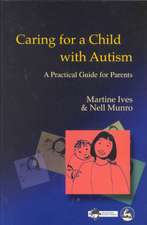Divorce and the Special Needs Child: A Guide for Parents
Autor Margaret "Pegi" Priceen Limba Engleză Paperback – 30 iun 2010
Preț: 166.61 lei
Preț vechi: 215.75 lei
-23% Nou
Puncte Express: 250
Preț estimativ în valută:
31.88€ • 33.38$ • 26.38£
31.88€ • 33.38$ • 26.38£
Carte disponibilă
Livrare economică 15-29 martie
Preluare comenzi: 021 569.72.76
Specificații
ISBN-13: 9781849058254
ISBN-10: 1849058253
Pagini: 269
Dimensiuni: 154 x 228 x 13 mm
Greutate: 0.38 kg
Editura: Jessica Kingsley Publishers Ltd
ISBN-10: 1849058253
Pagini: 269
Dimensiuni: 154 x 228 x 13 mm
Greutate: 0.38 kg
Editura: Jessica Kingsley Publishers Ltd
Notă biografică
Margaret "Pegi" Price is a family lawyer who specializes in divorces involving special needs children. She is a past Chair of the Family Law Section of the Bar Association of Metropolitan St. Louis, and a member of AFCC (Association of Family and Conciliation Courts) and the National Council on Family Relations (NCFR). She is also the author of The Special Needs Child and Divorce, published by the American Bar Association. She resides in St.Louis, Missouri.
Cuprins
Note. Disclaimer. About the Author. Preface. 1. Your Child's Special Needs. I. Types of Special Needs. II. Why Does this Matter in Divorce Court? III. Impact of Divorce on Special Needs Children. 2. How to Hire a Good Divorce Lawyer for Your Special Needs Case. I. Choosing Your Divorce Lawyer. II. Finding Good Candidates. III. The Interview. IV. The Lawyer's Approach and Personality. V. The Lawyer's Credentials. VI. Expectations. VII. Office Procedures and Practices. 3. How Does a Case Go through Divorce Court? I. Overview of Family Courts. II. The First Documents Filed with the Court. III. Additional Documents Filed with the Court. IV. Temporary Orders and Other Motions. V. Orders of Protection. VI. Court Meetings or Conferences. VII. Discovery. VIII. What You Need to Know before the First Court Date. IX. Settlement or Trial. 4. What Is Different about Your Case? I. Child Custody and Visitation. II. Child Support. III. Alimony (Maintenance or Spousal Support). IV. Property Distribution & Retirement Accounts. V. Guardian Ad Litem. VI. Expert Witnesses. VII. Proving Your Case to the Court. VII. Parenting Plan. IX. Settlement Agreement. X. Judgement. 5. Child Custody & Visitation. I. Primary Caregiver Parent. II. Parent Training. III. Logistical Considerations. I. Parental Denial. II. Lack of Cooperation/Medical or Educational Neglect. III. Child's Schedule. IV. Environmental Modifications. V. What Does Physical Custody Mean? VI. What Does Legal Custody Mean? 6. Child Support. I. Current Expenses. II. Therapy, Equipment & Medications. III. Supplements, Dietary Costs and Sensory Items. IV. Respite Care. V. Professionals. VI. Home Modifications. VII. Future Changes in the Child's Condition or Needs. 7. Alimony (Maintenance or Spousal Support). I. Primary Caregiver's Job Future. II. Primary Caregiver's Future Retirement Savings. III. How the Noncustodial Parent Can Help. 8. Property Distribution & Retirement Accounts. I. How do we Split up the House and Other Property? II. What Should We Do about the Debts? III. How Do We Handle the Retirement Accounts? 9. How You Can Help Your Lawyer Get the Best Result. I. Reasonable Expectations. II. Be Cooperative, Not Confrontational. III. Collect Medical and Educational Documents. IV. Help Educate Your Lawyer On Your Child's Special Needs. V. Get Evaluations and Reports. VI. Guardian Ad Litem. VII. Expert Witnesses. VIII. Translate the Jargon for Your Lawyer. 10. Tying up Loose Ends. I. Share Information. II. Sign Releases and Authorizations. III. Papers to Sign. IV. Car Titles, Mortgages & Quit Claim Deeds. V. Bank and Financial Accounts. VI. Employers and Insurance. VII. Retirement Accounts. VIII. Schools, Day Care, Therapists & Doctors. 11. Life after Divorce. I. Your New Reality. II. Two Households and Visitation. III. Less Money, More Expenses. IV. Future Relationships. V. Protecting Your Child. 12. What to Do When Things Change in the Future. I. When Can the Court Help Me in the Future? II. What Should I Do Then? 13. Resources. 14. Bibliography. 15. Checklists. References. Sample Documents. Glossary. Index.











